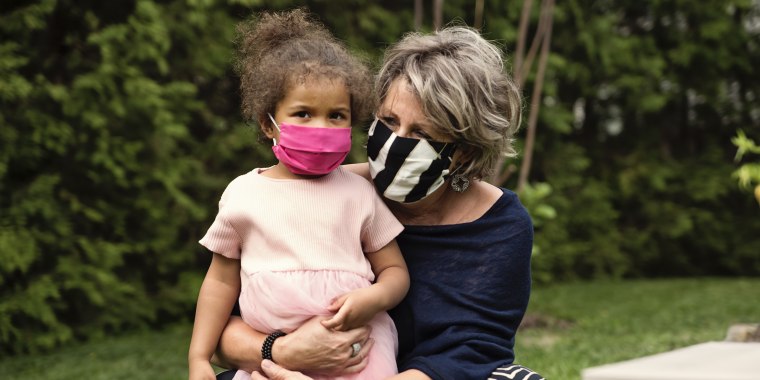By July, a 102-year-old member of Dr. Adrian Cotton’s family had been mostly stuck in a small room at her assisted living facility for four months — ever since the start of the coronavirus pandemic.
“She finally got enough of it and said, ‘I want out of jail, I’m going to go stay with some friends,’” Cotton, an internal medicine physician and chief of medical operations at Loma Linda University Health in California, told TODAY.
And that’s exactly what his wife’s great-aunt did last month, moving into the home of family friends for two weeks. Cotton wasn’t worried about the centenarian — a woman who used to drive an hour to Los Angeles to take her girlfriends to Dodgers games until she was in her mid-90s. She was tested for coronavirus after her vacation and the result was negative.
Loma Linda is famous as a place for healthy aging and one of the “Blue Zones” where residents live extraordinarily long lives. Cotton has seen patients in their 90s come into the hospital with COVID-19 and recover.
But this is a complicated time for people over 65, who are at highest risk for getting the severe form of the disease and dying from it.
At the start of the quarantine, the rules for this population were clear: stay at home.
Now, as doctors know more about the coronavirus and with states opening up, things are more vague. People are both tired of the quarantine and more relaxed about the rules. They’re eager to catch up with family and friends they haven’t seen since the spring even as COVID-19 cases continue to rise this summer.
“Probably for people our age, one of the big issues is grandchildren,” said Dr. Leo Cooney Jr., a geriatric clinician at Yale Medicine in New Haven, Connecticut, who is over 70 and has been cautiously reuniting with his grandkids. They progressed from Zoom calls, to staying far apart in a backyard, to quick hugs while wearing masks.
“There are ways that you can get out of the house, that you can socially interact, but you have to do it carefully. To just take a plane or go to a gym or go to a resort in August of 2020 is not a good idea no matter where you are,” he noted.
TODAY asked Cooney and Cotton to weigh in on some common scenarios older adults may face right now and the risks they present.
Both experts emphasized following the basic precautions: social distancing, wearing a face covering, staying outside as much as possible when going out and avoiding large gatherings.
Traveling and vacation:
The risk depends on where you’re going, where you’re coming from and the status of the pandemic in that area.
For a holiday, Cooney advised picking an uncrowded spot that’s within a day’s trip and where there’s little disease.
“So if people want to take a vacation in a cabin in Maine, where they’re driving to and where there won’t be a lot of people, that’s probably fine,” Cooney noted. It’s a different story if you want to go to a busy resort in Florida, where there’s been a spike in cases.
When it came to flying, the experts had different opinions. Cooney advised older adults to avoid planes if possible, but Cotton said the risk is low if you’re sitting in a mask next to people you know on a plane that has HEPA filtered air. Still, it’s safer to be in your car than a plane from an infection standpoint, he agreed.
The greatest risk of exposure comes from being closer than 6 feet to someone who has COVID-19 for more than 15 minutes without wearing any protective gear, according to the Centers for Disease Control and Prevention.
Having such an interaction with a stranger is rare now, Cotton pointed out, so he also thought staying at a hotel would be low risk.
“But everyone has to decide the risk level they’re comfortable with,” he noted.
Going out to eat:
Pick a restaurant where you can eat outside, it’s not crowded and the tables are spaced far apart, both experts advised.
The virus is diluted outdoors where there’s a lot of air circulation. Plus, ultraviolet light from the sun inactivates it quickly. Avoid crowded indoor bars: “Bars are terrible places” when it comes in infection risk, Cooney said.
Going to church:
The churches Cooney is involved with use very strict precautions, such as only admitting a certain number of people, seating them far apart, asking them not to sing and requiring masks. That makes it reasonably safe, he noted.
Going to the gym:
Both experts advised older adults to stick to outdoor exercise like walking and avoid going to the gym.
Many health clubs don’t require members to wear a face covering, which means people who are breathing hard during exercise are going to spread more viral particles or respiratory droplets, Cotton warned.
Hugging grandchildren:
A quick hug should be OK, with some important caveats.
Consider the risk that the kids might be carrying the coronavirus. A recent study found young children may be able to spread COVID-19 as easily as adults, even if they aren't that sick.
“If (your grandkids) lived in an area where there was a lot of virus, or had recently traveled to an area where there was a lot of virus, I would be very careful,” Cooney said. His grandchildren come from a place where there’s very little COVID-19, so the risk is low but it’s not zero, he added.
If you decide to proceed, both grandchildren and grandparents should be wearing masks and the embrace should be short.
“If you want to be truly safe from catching this coronavirus, you should never see anybody else ever again,” Cotton noted. “Most people aren’t willing to accept that.”




